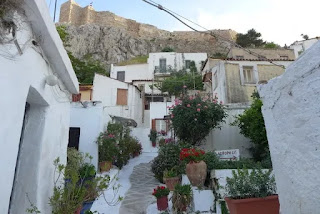HOW ATHENS’ NEIGHBOURHOODS AND SQUARES GOT THEIR NAMES
There are several famous but strangely named neighbourhoods
and squares in Athens and even Athenians don’t know they got their
names.
PLATEIA AMERIKIS, American square, is an iconic square in
Athens. The square was named in 1927, as
the municipal council wanted to show their appreciation for the philhellenism
shown by the USA. Until then it was
called Agamon Square (the square of the unmarried). It was named so because in 1887 4
middle-aged men, who had a café on the
square were all unwed.
Until the end of the 19th century AMPELOKIPI
(vineyards in Greek) and was indeed full of vineyards and orchards, which were
irrigated by the Adrianou aqueduct that sprouted from Agios Dimitrios from the
beginning of the 16th century when the pipeline was destroyed.
ANAFIOTIKA is an Athenian neighbourhood on the north slope
of the Acropolis Hill, particularly picturesque, with tiny houses and narrow
lanes resembling a Greek island. It was
created around 1860 by craftsmen and labourers who had come from the island of
Anafi to work on the excavation of the Acropolis and parts of Athens which was
Greece’s new capital then. They also
built houses for themselves. Thus
Anafiotika (little Anafi) was built.
VATHI or deep Square took its name from the lower part of
the city, where the waters of the Cycloborus steam ended. Once the area was drained for construction, Vathi Square was created in 1926.
GAZOCHORI or Gas Village was a settlement of shacks and
shelters built on the north and west of the gas factory during the first
decades of the reign of King George I. Originally, the poorest residents of
Athens lived there. Today, it is called
Gazi. and it is a vibrant area with trendy bars and gourmet restaurants. The old gas factory is turned into a complex
where concerts, exhibitions and other events are staged.
VOTANIKOS Square was named after the Botanical Gardens,
which since 1836 has been planted, under King Otto’s order for the establishment
of greenery in Athens. Under the same
order, the Botanical Gardens should be used by
the Physical-Historical Society, medical schools and institutions of higher
education in the city.
YUSURUM Square, the flea market in Monastiraki, was so named because of the Greek-Jewish entrepreneur, Elias Yusurum, who opened the first
antique in the area, in the late 19h century.
In
MONASTIRAKI there is also a flea market, usually packed with tourists, all
year round, due to its proximity to the Acropolis and other archaeological sites.
Monastiraki or little monastery owes its name to the monastery of the Assumption
of the Virgin Mary, the enclosure of which gave its name to Monasteraki Square.
EXARCHIA got
its name, around 1900, from a man called
Exarchos from Epirus who had a grocery store in the area. The famous Blue Apartment Building was built
before World War I. Today Exarchia is
inhabited mainly by artists,
The
neighbourhood of THESION is named after the temple ancient temple located in
the Agoraion Kolonos. Its ruins were
discovered in 1931, during the excavation of the American School of Classical
Studies. In the past, this temple was
converted into a Greek Orthodox Church and during the Frankish rule to a
Catholic Church.
ILLISIA was
named after the Duchess of Plakentia who built her mansion near Illisos river
and gave it the name of the river.
Today, the mansion house the Byzantine Museum.
KLATHMONOS
Square or the square of crying was named so because each time the government
changed the civil servants were fired and they cried when new ones took their
positions.
KOLONAKI the
little pillar, the downtown rich and famous neighbourhood took its name from the
stone landmark that existed until 1938 near Dexameny Square and was then set up
at Kolonaki Square.
PLAKA is a neighbourhood located a the foot of the Acropolis was mentioned the first time in an anonymous note “About Attica” in a Paris library dating back to the 17th century. It mentioned various Albanian houses in the area. In 1833, J Hann observed that Plaka comes from a language spoken by Albanians, who moved to Greece during the Middle Ages, and means old, aged. As K. Biris writes, “It is a medieval name, which arose after the end of the 16th century when they was a settlement of Arvenites outside the Valerian Wall.”
PLEASE DO BE VACCINATED AGAINST COVID - 19 SO THATYOIUR BELOVED FAMILIES, FRIENDS, THE WORLD AND YOU WILL REMAIN HEALTHY AND SAFE BECAUSE COVID IS DEATH.


No comments:
Post a Comment